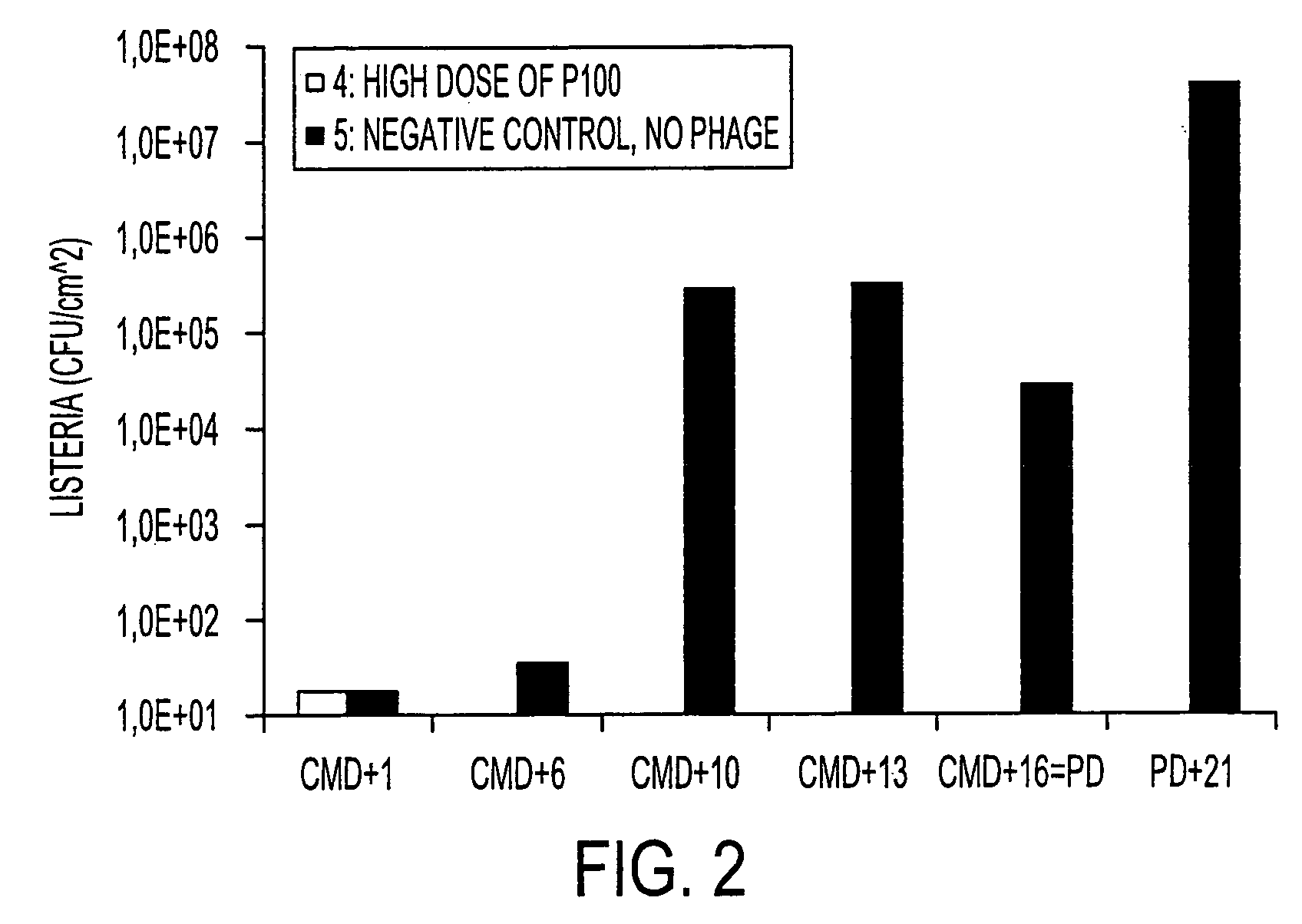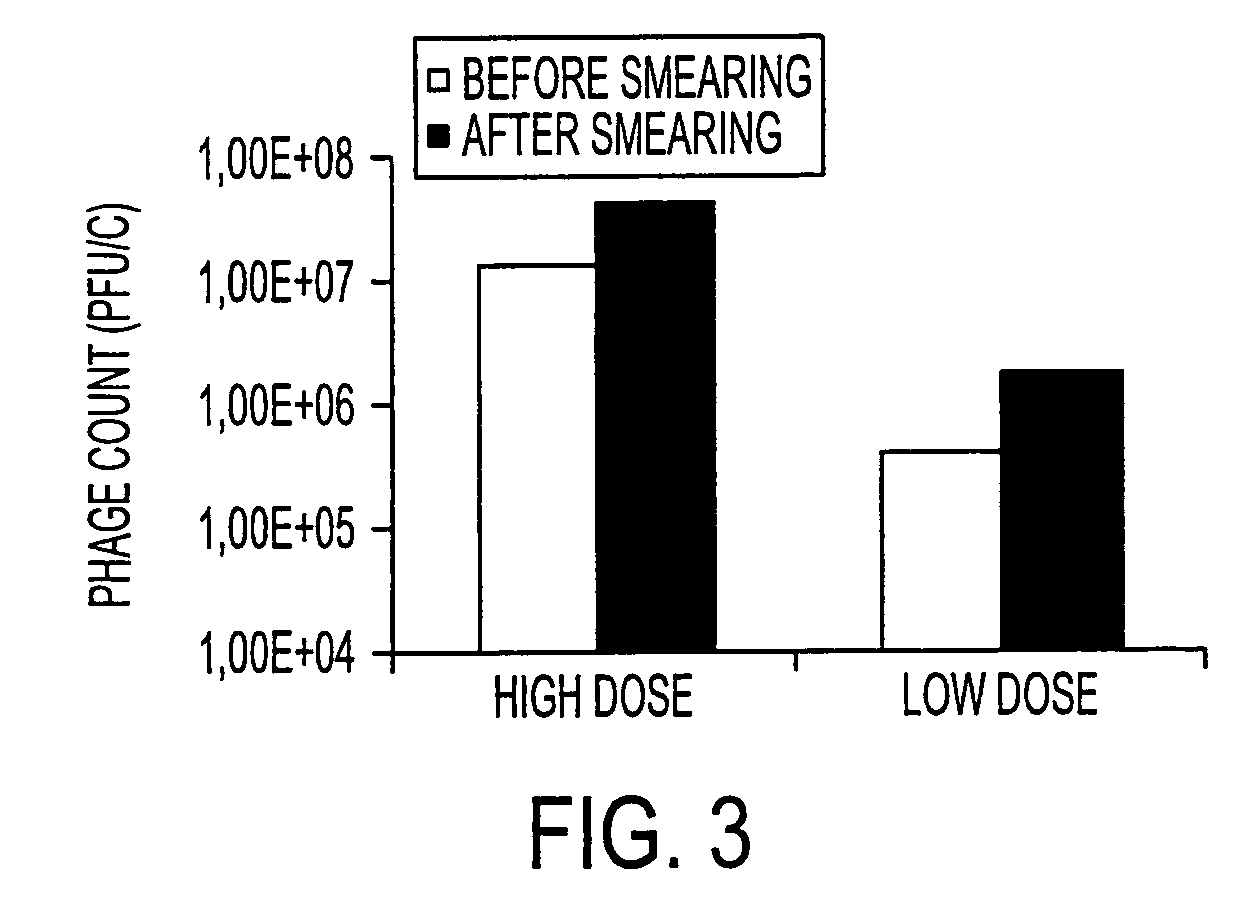Virulent phages to control Listeria monocytogenes in foodstuffs and in food processing plants
a technology of listeria monocytogenes and phages, which is applied in the direction of biocide, antibacterial agents, peptide sources, etc., can solve the problems of food that has been pasteurized at temperatures high enough to kill listeria monocytogenes but still become contaminated, and scores of deaths, so as to prevent their growth, reduce the count of listeria monocytogenes, and high substrate specificity
- Summary
- Abstract
- Description
- Claims
- Application Information
AI Technical Summary
Benefits of technology
Problems solved by technology
Method used
Image
Examples
example 1
Eradication of Listeria monocytogenes in a Liquid Culture:
[0052]Step 1. 103 CFUs of Listeria monocytogenes are mixed in a liquid culture.[0053]Step 2. 5×108 PFU of phage P100 are mixed into the liquid culture.[0054]Step 3. As a control, the buffer in which phage P100 was suspended is mixed into an aliquot of the liquid culture.[0055]Step 4. Colony counts of the bacteria are performed at various intervals of time.
Results are shown in FIG. 1.
example 2
[0056]A challenge experiment was done using a strain of anti-Listeria monocytogenes phage known as P100, in a cheese model on lab scale. This experiment incorporated technical flora to achieve the surface-ripening qualities (taste, texture, etc.) characteristic of an established commercial cheese-making process. The strain of Listeria monocytogenes (“Lm”) known as strain C that was used in this experiment is a common contaminant of a certain cheese-making plant.
Materials and Methods
Challenge Experiment on Cheese
[0057]The experiment was carried out on cheese taken directly from the brine (unadjusted pH).[0058]Lm strain C, technical flora, and phage P100 were applied on the cheese at t=0 by plating 210 μL or 1 mL of incubation mix on 64 cm2 cheese surface. t=0 is the same as “CMD+1” (Cheese Making Day+1). Cheeses treated with 1 mL solution were subsequently dried in a laminar flow cabinet to dry the surface. The incubation mix consisted of:[0059]110 g / L NaCl[0060]Technical flora:[0061...
example 3
Assay, Overexpression and Purification of Endolysins from E. coli JM109(pHPLxxx) Plate Assay
[0086]1. Prepare Listeria monocytogenes assay strain for activity testing: grow 1000 ml overnight-culture in tryptose broth or trypticase soy broth, centrifuge, wash cells once with SM Buffer, pH 8.0 (see Sambrook et al., 1989), (or PBS), and resuspend in 20 ml SM Buffer (or PBS) (approx. 50-fold concentration).[0087]2. Store in 1 ml amounts at −20° C. or at −80° C.[0088]3. Streak or plate E. coli JM109(pHPLxxx) on LB-agar (containing 100 μg / ml ampicillin), and incubate overnight.[0089]4. When colonies are of sufficient size, prepare replica plate (with NC-filters) on LB-Amp plates supplemented with 1 mM IPTG. Incubate for 5-7 hours until small colonies are visible.[0090]5. Expose surface of plate (upside down) to filter paper saturated with chloroform, for 5 min.[0091]6. Quickly overlay the colonies with 3-4 ml of molten soft agar (0.4%, in SM Buffer, approx. 45° C.), supplemented with 0.5 m...
PUM
| Property | Measurement | Unit |
|---|---|---|
| volume | aaaaa | aaaaa |
| pH | aaaaa | aaaaa |
| time | aaaaa | aaaaa |
Abstract
Description
Claims
Application Information
 Login to View More
Login to View More - R&D
- Intellectual Property
- Life Sciences
- Materials
- Tech Scout
- Unparalleled Data Quality
- Higher Quality Content
- 60% Fewer Hallucinations
Browse by: Latest US Patents, China's latest patents, Technical Efficacy Thesaurus, Application Domain, Technology Topic, Popular Technical Reports.
© 2025 PatSnap. All rights reserved.Legal|Privacy policy|Modern Slavery Act Transparency Statement|Sitemap|About US| Contact US: help@patsnap.com



